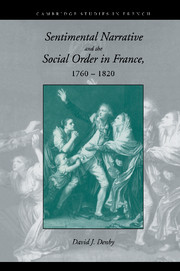Book contents
- Frontmatter
- Contents
- Acknowledgements
- Note on spelling
- Introduction: the politics of tears
- 1 Three sentimental writers
- 2 Towards a model of the sentimental text
- 3 Love and money: social hierarchy in the sentimental text
- 4 Sentimentalism in the rhetoric of the Revolution
- 5 Sentimentalism and idéologie
- 6 Beyond sentimentalism? Madame de Staël
- Conclusions
- Notes
- Bibliography
- Index
- CAMBRIDGE STUDIES IN FRENCH
3 - Love and money: social hierarchy in the sentimental text
Published online by Cambridge University Press: 29 August 2009
- Frontmatter
- Contents
- Acknowledgements
- Note on spelling
- Introduction: the politics of tears
- 1 Three sentimental writers
- 2 Towards a model of the sentimental text
- 3 Love and money: social hierarchy in the sentimental text
- 4 Sentimentalism in the rhetoric of the Revolution
- 5 Sentimentalism and idéologie
- 6 Beyond sentimentalism? Madame de Staël
- Conclusions
- Notes
- Bibliography
- Index
- CAMBRIDGE STUDIES IN FRENCH
Summary
In the previous chapter, I was principally concerned with the formal properties of the sentimental text: I outlined a general model of the ways in which it goes about the task of signifying. But if the emphasis of the chapter was in that sense on the aesthetic aspects of the text, the intention was not to suggest that these aspects can be separated from the overall social and historical insertion of the sentimental phenomenon. On the contrary, formal analysis led me to two conclusions directly relevant to the social and historical role of sentimentalism: firstly, that an explicitly imagined readership is crucially important in the hermeneutic of the sentimental text; and, secondly, that the underlying dynamic of the sentimental narrative – its drive to establish happiness through the conquest and elimination of adversity – finds an important parallel in the historical utopianism of Enlightenment.
In the present chapter, I propose to focus more exclusively on the treatment of social questions by the sentimental text – what the text signifies in social terms rather than how it goes about that process of signifying. Such an analysis should start from notions of social hierarchy, power and domination. We have already seen that the privileged focus of the process of sentimentalisation is the figure of the victim: misfortune and suffering are the primary conditions of sentimentalisation.
- Type
- Chapter
- Information
- Publisher: Cambridge University PressPrint publication year: 1994



